This site uses cookies as defined in our Cookie Policy, by continuing to use this site you agree to their use.
Continue
Sail from Athens to the most idyllic Greek Isles in the Med — like Santorini, Rhodes, and Crete. With an overnight in the glamorous hot spot of Mykonos (9 am to 2 pm the next day), you can immerse yourself in the quiet charm of the island and attend those world-famous beach club parties.
| Arrive | Depart | ||||||
| 3rd03 | AugAug | 202525 | Piraeus, Greece, embark on the Resilient Lady | 18:00 | |||
It's no wonder that all roads lead to the fascinating and maddening metropolis of Athens. Lift your eyes 200 feet above the city to the Parthenon, its honey-color marble columns rising from a massive limestone base, and you behold architectural perfection that has not been surpassed in 2,500 years. But, today, this shrine of classical form dominates a 21st-century boomtown. To experience Athens—Athína in Greek—fully is to understand the essence of Greece: ancient monuments surviving in a sea of cement, startling beauty amid the squalor, tradition juxtaposed with modernity. Locals depend on humor and flexibility to deal with the chaos; you should do the same. The rewards are immense. Although Athens covers a huge area, the major landmarks of the ancient Greek, Roman, and Byzantine periods are close to the modern city center. You can easily walk from the Acropolis to many other key sites, taking time to browse in shops and relax in cafés and tavernas along the way. From many quarters of the city you can glimpse "the glory that was Greece" in the form of the Acropolis looming above the horizon, but only by actually climbing that rocky precipice can you feel the impact of the ancient settlement. The Acropolis and Filopappou, two craggy hills sitting side by side; the ancient Agora (marketplace); and Kerameikos, the first cemetery, form the core of ancient and Roman Athens. Along the Unification of Archaeological Sites promenade, you can follow stone-paved, tree-lined walkways from site to site, undisturbed by traffic. Cars have also been banned or reduced in other streets in the historical center. In the National Archaeological Museum, vast numbers of artifacts illustrate the many millennia of Greek civilization; smaller museums such as the Goulandris Museum of Cycladic Art Museum and the Byzantine and Christian Museum illuminate the history of particular regions or periods. Athens may seem like one huge city, but it is really a conglomeration of neighborhoods with distinctive characters. The Eastern influences that prevailed during the 400-year rule of the Ottoman Empire are still evident in Monastiraki, the bazaar area near the foot of the Acropolis. On the northern slope of the Acropolis, stroll through Plaka (if possible by moonlight), an area of tranquil streets lined with renovated mansions, to get the flavor of the 19th-century's gracious lifestyle. The narrow lanes of Anafiotika, a section of Plaka, thread past tiny churches and small, color-washed houses with wooden upper stories, recalling a Cycladic island village. In this maze of winding streets, vestiges of the older city are everywhere: crumbling stairways lined with festive tavernas; dank cellars filled with wine vats; occasionally a court or diminutive garden, enclosed within high walls and filled with magnolia trees and the flaming trumpet-shaped flowers of hibiscus bushes. Formerly run-down old quarters, such as Thission, Gazi and Psirri, popular nightlife areas filled with bars and mezedopoleia (similar to tapas bars), are now in the process of gentrification, although they still retain much of their original charm, as does the colorful produce and meat market on Athinas. The area around Syntagma Square, the tourist hub, and Omonia Square, the commercial heart of the city about 1 km (½ mi) northwest, is distinctly European, having been designed by the court architects of King Otho, a Bavarian, in the 19th century. The chic shops and bistros of ritzy Kolonaki nestle at the foot of Mt. Lycabettus, Athens's highest hill (909 feet). Each of Athens's outlying suburbs has a distinctive character: in the north is wealthy, tree-lined Kifissia, once a summer resort for aristocratic Athenians, and in the south and southeast lie Glyfada, Voula, and Vouliagmeni, with their sandy beaches, seaside bars, and lively summer nightlife. Just beyond the city's southern fringes is Piraeus, a bustling port city of waterside fish tavernas and Saronic Gulf views. Bright blue skies, sand-fringed shores, and a bustling street art scene — few places are as colorful as this ever-evolving city. | |||||||
| 4th04 | AugAug | 202525 | Santorini, Greece | 08:00 | 20:00 | ||
Undoubtedly the most extraordinary island in the Aegean, crescent-shape Santorini remains a mandatory stop on the Cycladic tourist route—even if it's necessary to enjoy the sensational sunsets from Ia, the fascinating excavations, and the dazzling white towns with a million other travelers. Called Kállisti (the "Loveliest") when first settled, the island has now reverted to its subsequent name of Thira, after the 9th-century-BC Dorian colonizer Thiras. The place is better known, however, these days as Santorini, a name derived from its patroness, St. Irene of Thessaloniki, the Byzantine empress who restored icons to Orthodoxy and died in 802. You can fly conveniently to Santorini, but to enjoy a true Santorini rite of passage, opt instead for the boat trip here, which provides a spectacular introduction. After the boat sails between Sikinos and Ios, your deck-side perch approaches two close islands with a passage between them. The bigger one on the left is Santorini, and the smaller on the right is Thirassia. Passing between them, you see the village of Ia adorning Santorini's northernmost cliff like a white geometric beehive. You are in the caldera (volcanic crater), one of the world's truly breathtaking sights: a demilune of cliffs rising 1,100 feet, with the white clusters of the towns of Fira and Ia perched along the top. The bay, once the high center of the island, is 1,300 feet in some places, so deep that when boats dock in Santorini's shabby little port of Athinios, they do not drop anchor. The encircling cliffs are the ancient rim of a still-active volcano, and you are sailing east across its flooded caldera. On your right are the Burnt isles, the White isle, and other volcanic remnants, all lined up as if some outsize display in a geology museum. Hephaestus's subterranean fires smolder still—the volcano erupted in 198 BC, about 735, and there was an earthquake in 1956. Indeed, Santorini and its four neighboring islets are the fragmentary remains of a larger landmass that exploded about 1600 BC: the volcano's core blew sky high, and the sea rushed into the abyss to create the great bay, which measures 10 km by 7 km (6 mi by 4½ mi) and is 1,292 feet deep. The other pieces of the rim, which broke off in later eruptions, are Thirassia, where a few hundred people live, and deserted little Aspronissi ("White isle"). In the center of the bay, black and uninhabited, two cones, the Burnt Isles of Palea Kameni and Nea Kameni, appeared between 1573 and 1925. There has been too much speculation about the identification of Santorini with the mythical Atlantis, mentioned in Egyptian papyri and by Plato (who says it's in the Atlantic), but myths are hard to pin down. This is not true of old arguments about whether tidal waves from Santorini's cataclysmic explosion destroyed Minoan civilization on Crete, 113 km (70 mi) away. The latest carbon-dating evidence, which points to a few years before 1600 BC for the eruption, clearly indicates that the Minoans outlasted the eruption by a couple of hundred years, but most probably in a weakened state. In fact, the island still endures hardships: since antiquity, Santorini has depended on rain collected in cisterns for drinking and irrigating—the well water is often brackish—and the serious shortage is alleviated by the importation of water. However, the volcanic soil also yields riches: small, intense tomatoes with tough skins used for tomato paste (good restaurants here serve them); the famous Santorini fava beans, which have a light, fresh taste; barley; wheat; and white-skin eggplants. As the Greek Goddess of the Cyclades Islands, Santorini is known for breathtaking panoramas, fiery orange and blue sunsets, and the famed red and black beaches. Take in views from the blue and white dotted hills of Oia, or enjoy locally-made wine while sailing along the waters of the Caldera coast. | |||||||
| 5th05 | AugAug | 202525 | Rhodes, Greece | 09:00 | 18:00 | ||
Early travelers described Rhodes as a town of two parts: a castle or high town (Collachium) and a lower city. Today Rhodes town—sometimes referred to as Ródos town—is still a city of two parts: the Old Town, a UNESCO World Heritage site that incorporates the high town and lower city, and the modern metropolis, or New Town, spreading away from the walls that encircle the Old Town. The narrow streets of the Old Town are for the most part closed to cars and are lined with Orthodox and Catholic churches, Turkish houses (some of which follow the ancient orthogonal plan), and medieval public buildings with exterior staircases and facades elegantly constructed of well-cut limestone from Lindos. Careful reconstruction in recent years has enhanced the harmonious effect. A hot spot for writers and artists, Rhodes is where the Byzantine Empire meets modern cultural ingenuity. Whether wandering the cobbled streets of Old Town for delicious Greek bites, exploring the perched-on-a-hill village of Lindos, or hitting up famed Faliraki Beach — this island truly has it all. | |||||||
| 6th06 | AugAug | 202525 | Bodrum, Turkey | 08:00 | 20:00 | ||
Beautiful beaches with crystalline waters. Chalk-white houses with bright-blue trim. Bodrum boasts Aegean character from its narrow streets with ancient ruins to its glitzy marina, flower-filled cafes, and world-class cuisine. | |||||||
| 7th07 | AugAug | 202525 | At Sea | ||||
| 8th08 | AugAug | 202525 | Mykonos, Greece | 09:00 | |||
Although the fishing boats still go out in good weather, Mykonos largely makes its living from tourism these days. The summer crowds have turned one of the poorest islands in Greece into one of the richest. Old Mykonians complain that their young, who have inherited stores where their grandfathers once sold eggs or wine, get so much rent that they have lost ambition, and in summer sit around pool bars at night with their friends, and hang out in Athens in winter when island life is less scintillating. Put firmly on the map by Jackie O in the 1960s, Mykonos town—called Hora by the locals—remains the Saint-Tropez of the Greek islands. The scenery is memorable, with its whitewashed streets, Little Venice, the Kato Myli ridge of windmills, and Kastro, the town's medieval quarter. Its cubical two- or three-story houses and churches, with their red or blue doors and domes and wooden balconies, have been long celebrated as some of the best examples of classic Cycladic architecture. Luckily, the Greek Archaeological Service decided to preserve the town, even when the Mykonians would have preferred to rebuild, and so the Old Town has been impressively preserved. Pink oleander, scarlet hibiscus, and trailing green pepper trees form a contrast amid the dazzling whiteness, whose frequent renewal with whitewash is required by law. Any visitor who has the pleasure of getting lost in its narrow streets (made all the narrower by the many outdoor stone staircases, which maximize housing space in the crowded village) will appreciate how its confusing layout was designed to foil pirates—if it was designed at all. After Mykonos fell under Turkish rule in 1537, the Ottomans allowed the islanders to arm their vessels against pirates, which had a contradictory effect: many of them found that raiding other islands was more profitable than tilling arid land. At the height of Aegean piracy, Mykonos was the principal headquarters of the corsair fleets—the place where pirates met their fellows, found willing women, and filled out their crews. Eventually the illicit activity evolved into a legitimate and thriving trade network. Morning on Mykonos town's main quay is busy with deliveries, visitors for the Delos boats, lazy breakfasters, and street cleaners dealing with the previous night's mess. In late morning the cruise-boat people arrive, and the shops are all open. In early afternoon, shaded outdoor tavernas are full of diners eating salads (Mykonos's produce is mostly imported); music is absent or kept low. In mid- and late afternoon, the town feels sleepy, since so many people are at the beach, on excursions, or sleeping in their air-conditioned rooms; even some tourist shops close for siesta. By sunset, people have come back from the beach, having taken their showers and rested. At night, the atmosphere in Mykonos ramps up. The cruise-boat people are mostly gone, coughing three-wheelers make no deliveries in the narrow streets, and everyone is dressed sexy for summer and starting to shimmy with the scene. Many shops stay open past midnight, the restaurants fill up, and the bars and discos make ice cubes as fast as they can. Ready to dive in? Begin your tour of Mykonos town (Hora) by starting out at its heart: Mando Mavrogenous Square. Mykonos may be famous for its beach club parties and electric nightlife, but the Greek Isle has a notably quiet side, too. With overnight stays, you can explore the charm of the cafe-lined waterfront promenades, or tour the vineyards tucked charmingly into the gorgeous hillsides of the island. | |||||||
| 9th09 | AugAug | 202525 | Mykonos, Greece | 14:00 | |||
Although the fishing boats still go out in good weather, Mykonos largely makes its living from tourism these days. The summer crowds have turned one of the poorest islands in Greece into one of the richest. Old Mykonians complain that their young, who have inherited stores where their grandfathers once sold eggs or wine, get so much rent that they have lost ambition, and in summer sit around pool bars at night with their friends, and hang out in Athens in winter when island life is less scintillating. Put firmly on the map by Jackie O in the 1960s, Mykonos town—called Hora by the locals—remains the Saint-Tropez of the Greek islands. The scenery is memorable, with its whitewashed streets, Little Venice, the Kato Myli ridge of windmills, and Kastro, the town's medieval quarter. Its cubical two- or three-story houses and churches, with their red or blue doors and domes and wooden balconies, have been long celebrated as some of the best examples of classic Cycladic architecture. Luckily, the Greek Archaeological Service decided to preserve the town, even when the Mykonians would have preferred to rebuild, and so the Old Town has been impressively preserved. Pink oleander, scarlet hibiscus, and trailing green pepper trees form a contrast amid the dazzling whiteness, whose frequent renewal with whitewash is required by law. Any visitor who has the pleasure of getting lost in its narrow streets (made all the narrower by the many outdoor stone staircases, which maximize housing space in the crowded village) will appreciate how its confusing layout was designed to foil pirates—if it was designed at all. After Mykonos fell under Turkish rule in 1537, the Ottomans allowed the islanders to arm their vessels against pirates, which had a contradictory effect: many of them found that raiding other islands was more profitable than tilling arid land. At the height of Aegean piracy, Mykonos was the principal headquarters of the corsair fleets—the place where pirates met their fellows, found willing women, and filled out their crews. Eventually the illicit activity evolved into a legitimate and thriving trade network. Morning on Mykonos town's main quay is busy with deliveries, visitors for the Delos boats, lazy breakfasters, and street cleaners dealing with the previous night's mess. In late morning the cruise-boat people arrive, and the shops are all open. In early afternoon, shaded outdoor tavernas are full of diners eating salads (Mykonos's produce is mostly imported); music is absent or kept low. In mid- and late afternoon, the town feels sleepy, since so many people are at the beach, on excursions, or sleeping in their air-conditioned rooms; even some tourist shops close for siesta. By sunset, people have come back from the beach, having taken their showers and rested. At night, the atmosphere in Mykonos ramps up. The cruise-boat people are mostly gone, coughing three-wheelers make no deliveries in the narrow streets, and everyone is dressed sexy for summer and starting to shimmy with the scene. Many shops stay open past midnight, the restaurants fill up, and the bars and discos make ice cubes as fast as they can. Ready to dive in? Begin your tour of Mykonos town (Hora) by starting out at its heart: Mando Mavrogenous Square. Mykonos may be famous for its beach club parties and electric nightlife, but the Greek Isle has a notably quiet side, too. With overnight stays, you can explore the charm of the cafe-lined waterfront promenades, or tour the vineyards tucked charmingly into the gorgeous hillsides of the island. | |||||||
| 10th10 | AugAug | 202525 | Piraeus, Greece, disembark the Resilient Lady | 06:30 | |||
It's no wonder that all roads lead to the fascinating and maddening metropolis of Athens. Lift your eyes 200 feet above the city to the Parthenon, its honey-color marble columns rising from a massive limestone base, and you behold architectural perfection that has not been surpassed in 2,500 years. But, today, this shrine of classical form dominates a 21st-century boomtown. To experience Athens—Athína in Greek—fully is to understand the essence of Greece: ancient monuments surviving in a sea of cement, startling beauty amid the squalor, tradition juxtaposed with modernity. Locals depend on humor and flexibility to deal with the chaos; you should do the same. The rewards are immense. Although Athens covers a huge area, the major landmarks of the ancient Greek, Roman, and Byzantine periods are close to the modern city center. You can easily walk from the Acropolis to many other key sites, taking time to browse in shops and relax in cafés and tavernas along the way. From many quarters of the city you can glimpse "the glory that was Greece" in the form of the Acropolis looming above the horizon, but only by actually climbing that rocky precipice can you feel the impact of the ancient settlement. The Acropolis and Filopappou, two craggy hills sitting side by side; the ancient Agora (marketplace); and Kerameikos, the first cemetery, form the core of ancient and Roman Athens. Along the Unification of Archaeological Sites promenade, you can follow stone-paved, tree-lined walkways from site to site, undisturbed by traffic. Cars have also been banned or reduced in other streets in the historical center. In the National Archaeological Museum, vast numbers of artifacts illustrate the many millennia of Greek civilization; smaller museums such as the Goulandris Museum of Cycladic Art Museum and the Byzantine and Christian Museum illuminate the history of particular regions or periods. Athens may seem like one huge city, but it is really a conglomeration of neighborhoods with distinctive characters. The Eastern influences that prevailed during the 400-year rule of the Ottoman Empire are still evident in Monastiraki, the bazaar area near the foot of the Acropolis. On the northern slope of the Acropolis, stroll through Plaka (if possible by moonlight), an area of tranquil streets lined with renovated mansions, to get the flavor of the 19th-century's gracious lifestyle. The narrow lanes of Anafiotika, a section of Plaka, thread past tiny churches and small, color-washed houses with wooden upper stories, recalling a Cycladic island village. In this maze of winding streets, vestiges of the older city are everywhere: crumbling stairways lined with festive tavernas; dank cellars filled with wine vats; occasionally a court or diminutive garden, enclosed within high walls and filled with magnolia trees and the flaming trumpet-shaped flowers of hibiscus bushes. Formerly run-down old quarters, such as Thission, Gazi and Psirri, popular nightlife areas filled with bars and mezedopoleia (similar to tapas bars), are now in the process of gentrification, although they still retain much of their original charm, as does the colorful produce and meat market on Athinas. The area around Syntagma Square, the tourist hub, and Omonia Square, the commercial heart of the city about 1 km (½ mi) northwest, is distinctly European, having been designed by the court architects of King Otho, a Bavarian, in the 19th century. The chic shops and bistros of ritzy Kolonaki nestle at the foot of Mt. Lycabettus, Athens's highest hill (909 feet). Each of Athens's outlying suburbs has a distinctive character: in the north is wealthy, tree-lined Kifissia, once a summer resort for aristocratic Athenians, and in the south and southeast lie Glyfada, Voula, and Vouliagmeni, with their sandy beaches, seaside bars, and lively summer nightlife. Just beyond the city's southern fringes is Piraeus, a bustling port city of waterside fish tavernas and Saronic Gulf views. Bright blue skies, sand-fringed shores, and a bustling street art scene — few places are as colorful as this ever-evolving city. | |||||||
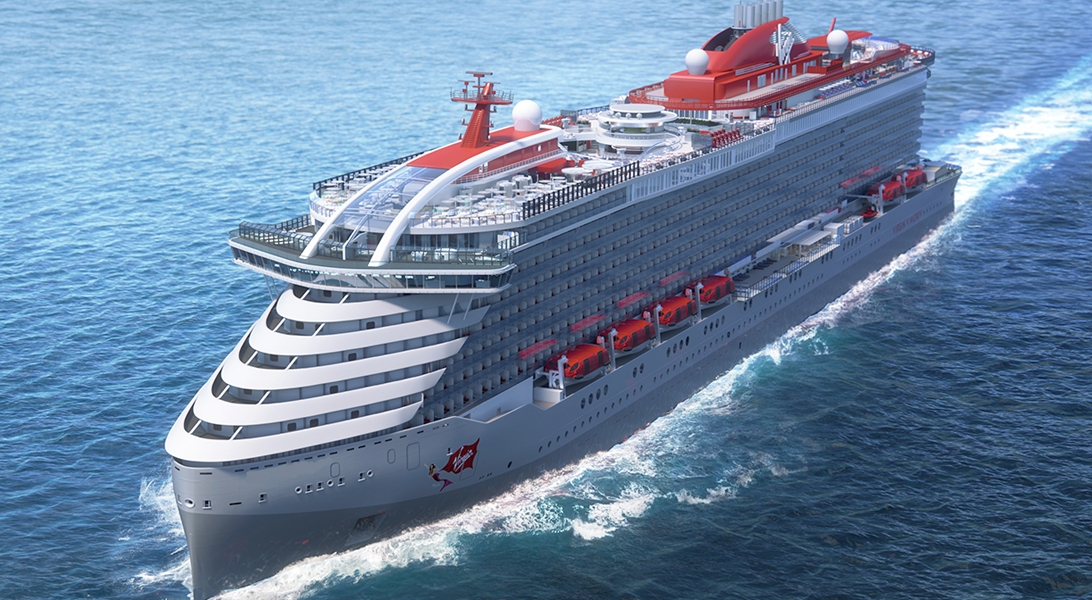
The images shown are for illustration purposes only and may not be an exact representation of what you find on the ship.
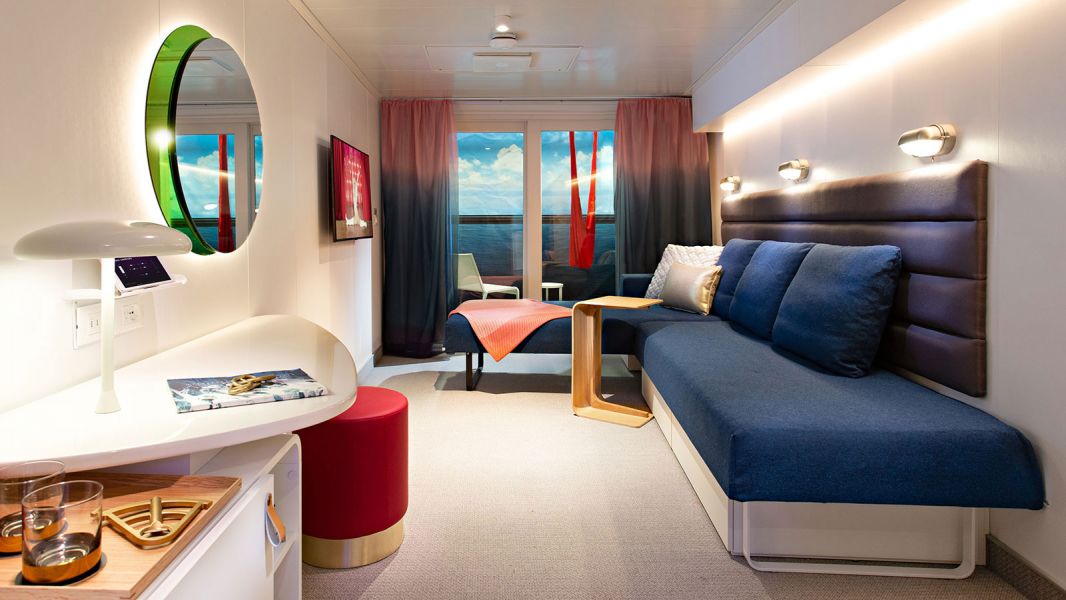
For Sailors who prefer to be mid ship, this cabin has all the comforts and amenities of The Sea Terrace, but is positioned closer to the action.
Featuring nautically inspired brass and leather finishings, this sensory and responsive clever cabin has it all from the personal∘ tablet, intuitive mood lighting, music controls, movie streaming, one-touch room service, European queen, transitional Seabed, handwoven terrace hammock and upgraded bathroom experience with a Roomy Rainshower. Sleeps up to three.
Heroes:
Unique Call-Outs:
Brilliant Basics:

Built for groups of Sailors, what happens inside this cabin, stays inside (because it’s sans windows). The bunk beds go from sleep∘ to sit in no time while the amenities in this sensory and responsive clever cabin match that of all other cabins, except the way bigger TV. Sleeps up to four.
Heroes:
Brilliant Basics:
Unique Call-Outs:
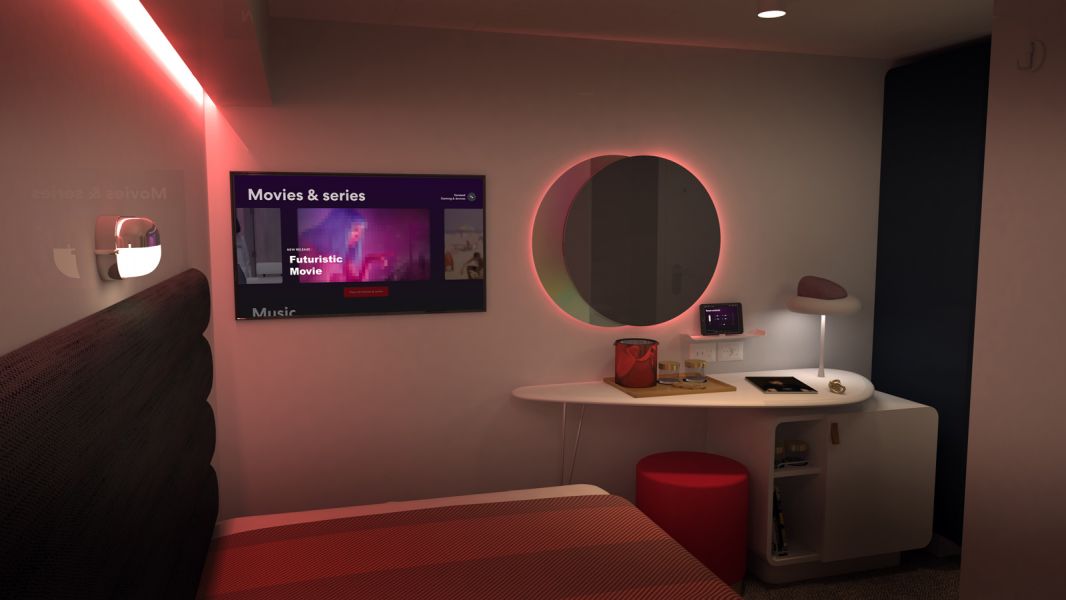
This cocoon-like cabin is perfect for fans of late nights and sleeping in until after lunch. It’s super cozy and ideal for solo travelers.
Standard cabin amenities, check. No window, no problem. Sleeps one.
Heroes:
Brilliant Basics:
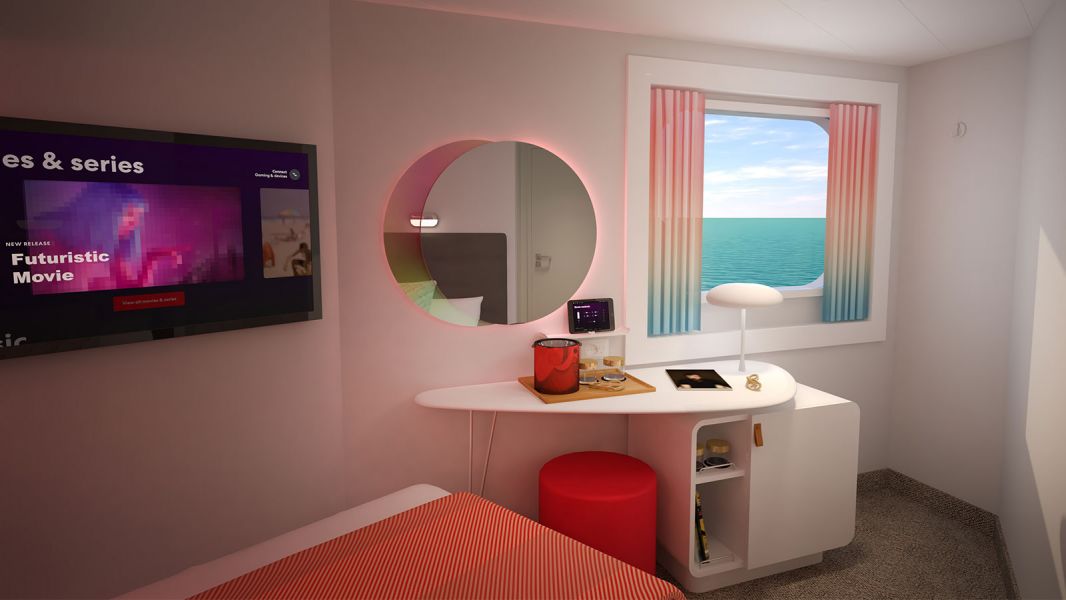
Views on views minus the messy hair. Sailors will enjoy all the amenities of cabin life while watching the waves∘ from a personal hideaway. It’s the closest Sailors can get to the ocean without getting wet (save that for the pool party). Sleeps one.
Heroes:
Brilliant Basics:
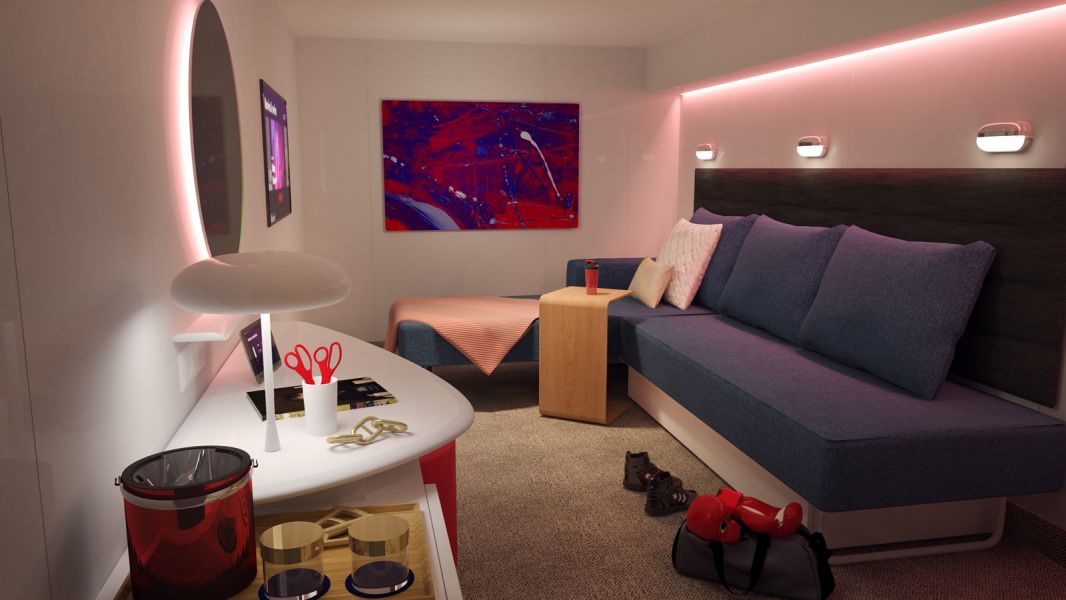
Nightlife type who prefers to catch Z’s without the morning sun peeking through the blinds? Then this window-free cabin will be perfect. Add in all the amenities of other cabins, just subtract the pesky glare. Sleeps up to three.
Heroes:
Brilliant Basics:
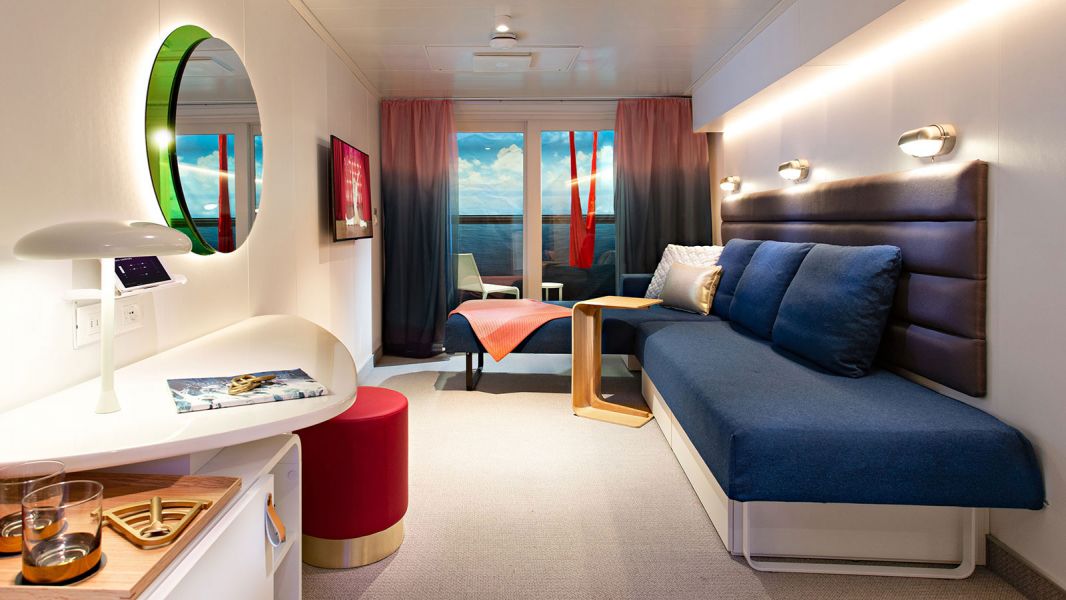
Epic ocean views, whether Sailors are inside on the European queen, transitional Seabed or dangling from the sustainable sourced, hand-woven terrace hammock.
Complete with nautically inspired brass and leather finishings, Sailors will enjoy this sensory and responsive∘ clever cabin. Just pick up the personal tablet to adjust the mood lighting, music controls, movie streaming or even one-touch room service.
Sea gaze outside or head in to freshen up under the Roomy Rainshower in the upgraded bathroom experience. Sleeps up to four
Heroes:
Unique Call-Outs:
Brilliant Basics:
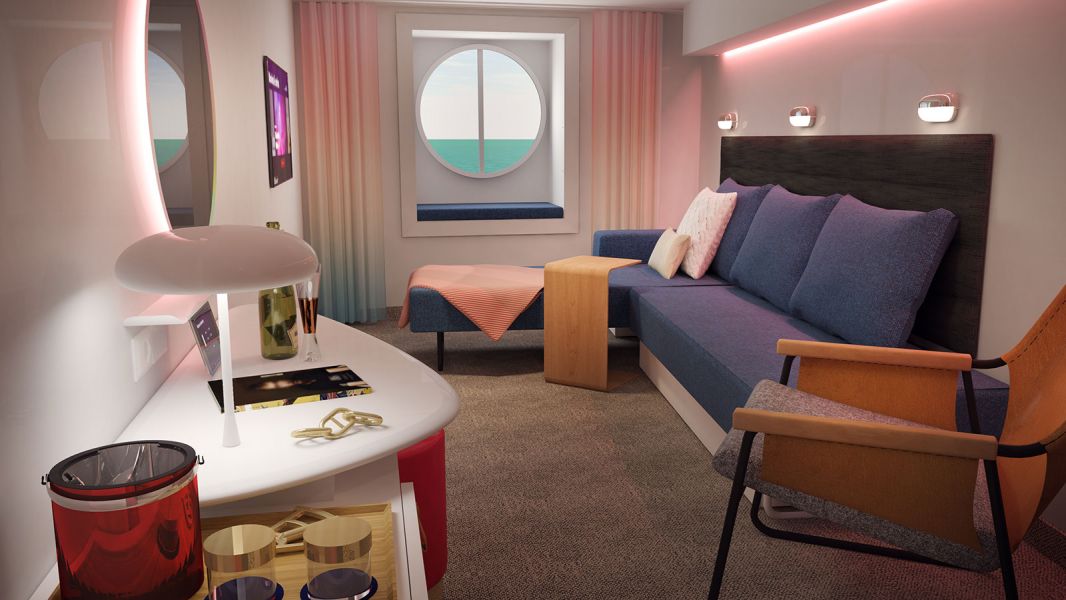
Views on views minus the messy hair. This cabin has all the amenities of cabin life with a window seat that’s the closest Sailors can get to the ocean without getting wet (save that for the pool party). Sleeps up to three.
Heroes:
Uniquie Call-Outs:
Brilliant Basics:
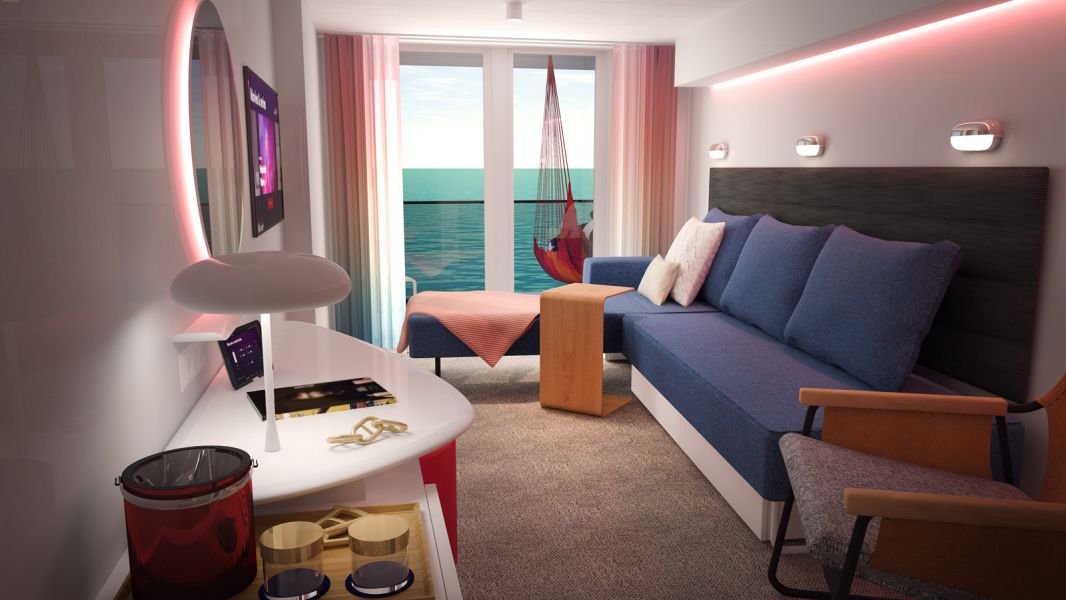
Just picture everything The Sea Terrace has, with more room space and a way bigger bathroom. Our biggest of all cabins actually. Perfect for those who make getting ready∘ a serious art.
A sensory and responsive clever cabin, nautically inspired brass and leather finishings, a personal tablet, intuitive mood lighting, music controls, movie streaming, one-touch room service and a supremely comfy European queen, transitional Seabed. Plus the large, perfectly partitioned, upgraded walk-in bathroom has enough space for two. Even the Roomier Rainshower boasts just the right amount of space for some “we” time. Sleeps up to three.
Heroes:
Unique Call-Outs:
Brilliant Basics:
The images shown are for illustration purposes only and may not be an exact representation of what you find on the ship.
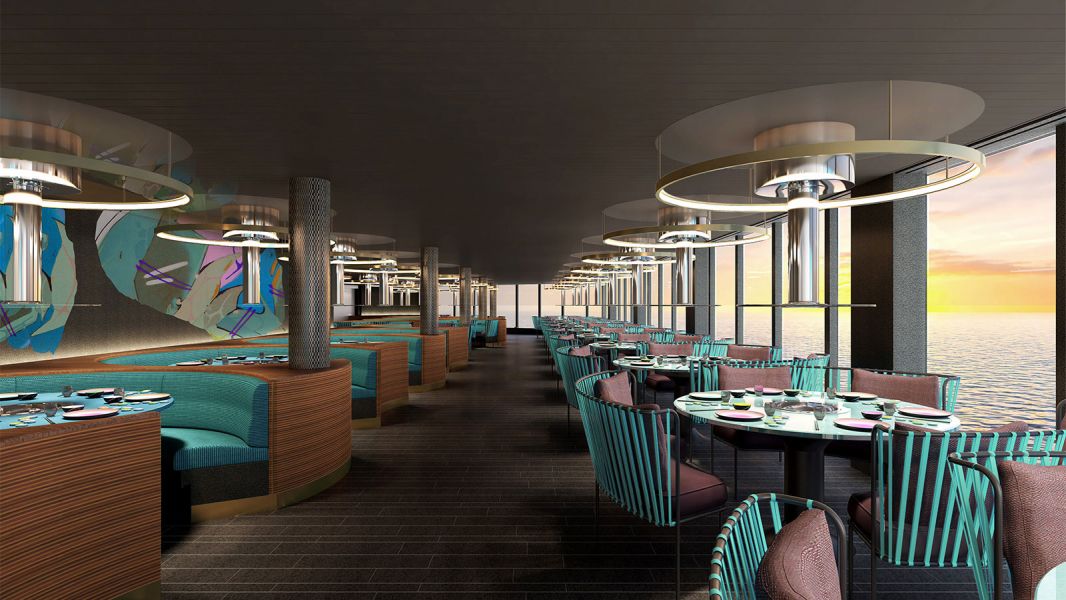
If you're into hands-on meat-grilling and soju drinking, the Korean BBQ is the perfect spot. Sailors have the option to choose from meats, seafood, vegetables, or all of the above when they’re ready to start grilling and our crew will be on hand to help. Virgin Voyages specially designed a flameless grill for the ultimate BBQ experience, which will be the centerpiece of the loudest restaurant at sea.
FEATURES
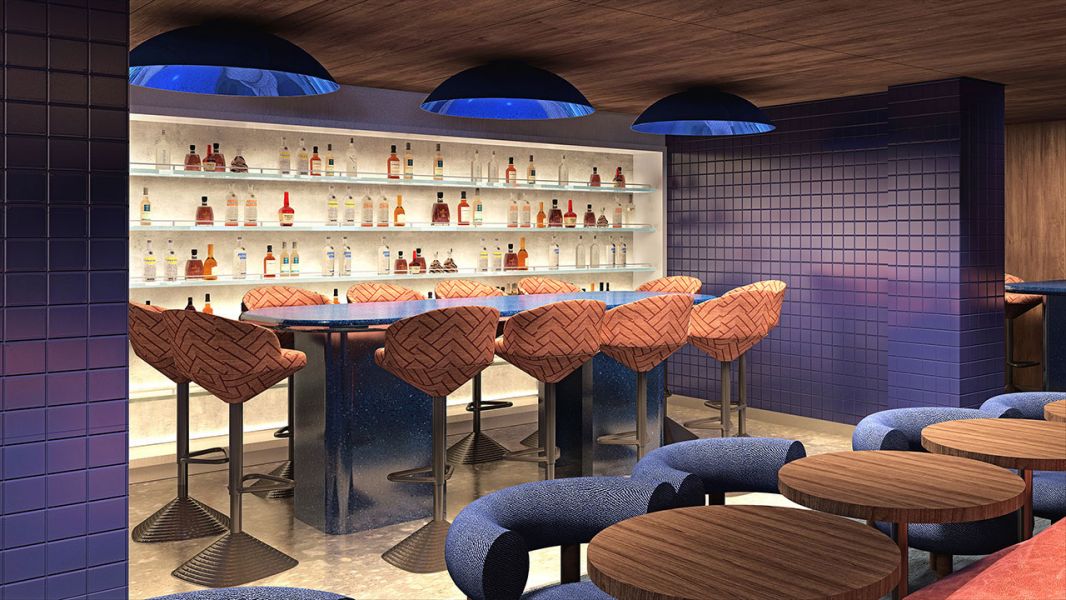
Inspired by the vibrant, colorful streets of Mexico, Sailors are treated to a menu reflecting the regions emerging culinary renaissance. Personal, intimate, and educational, our mezcalier will guide you through a highly curated dining and drinking experience. Pink Agave is our tribute to sophisticated Mexican Cuisine, and home to our impressive mezcal and tequila collection.
FEATURES
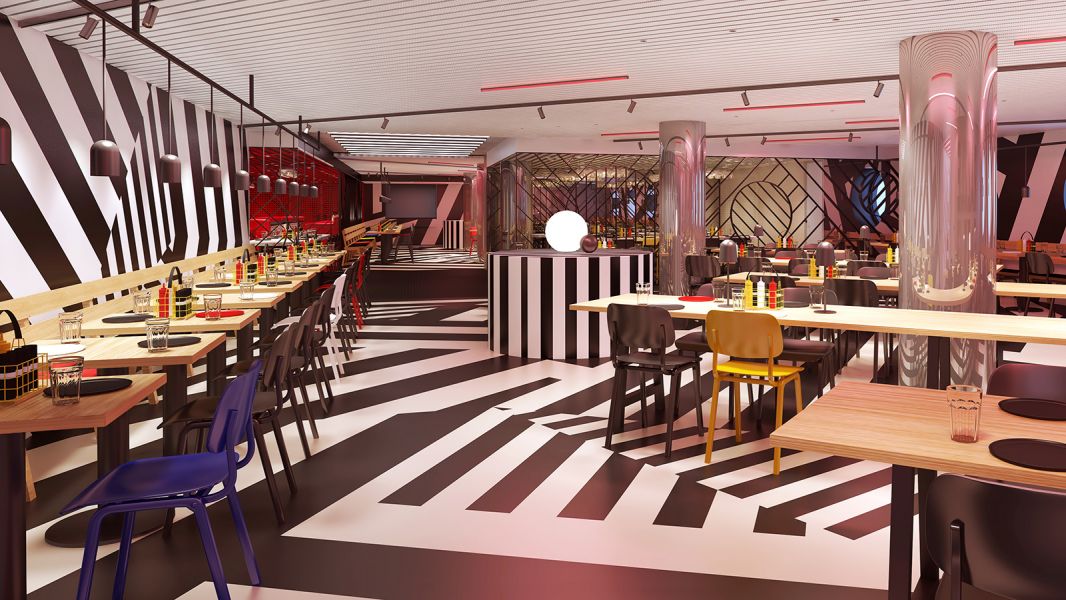
One of our most unique offerings onboard, Razzle Dazzle Restaurant is a veggie-forward eatery that delivers a healthy dose of nice with just the right amount of naughty. Sailors can choose from one side that skews towards plant-based vegetarian and vegan dishes including must have munchies such as the Impossible Burger, or the indulgent side – meaty cheats, sweets and gluttonous treats. Sailors can enjoy healthy smoothies and juices by day and the retox with signature cocktails by night in a lively, bustling environment.
FEATURES
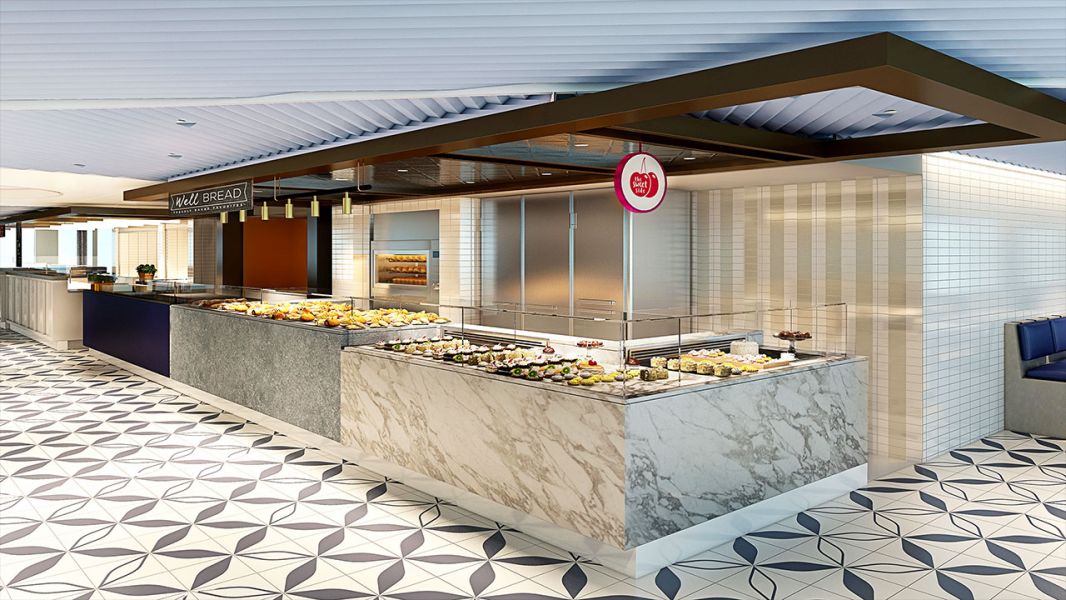
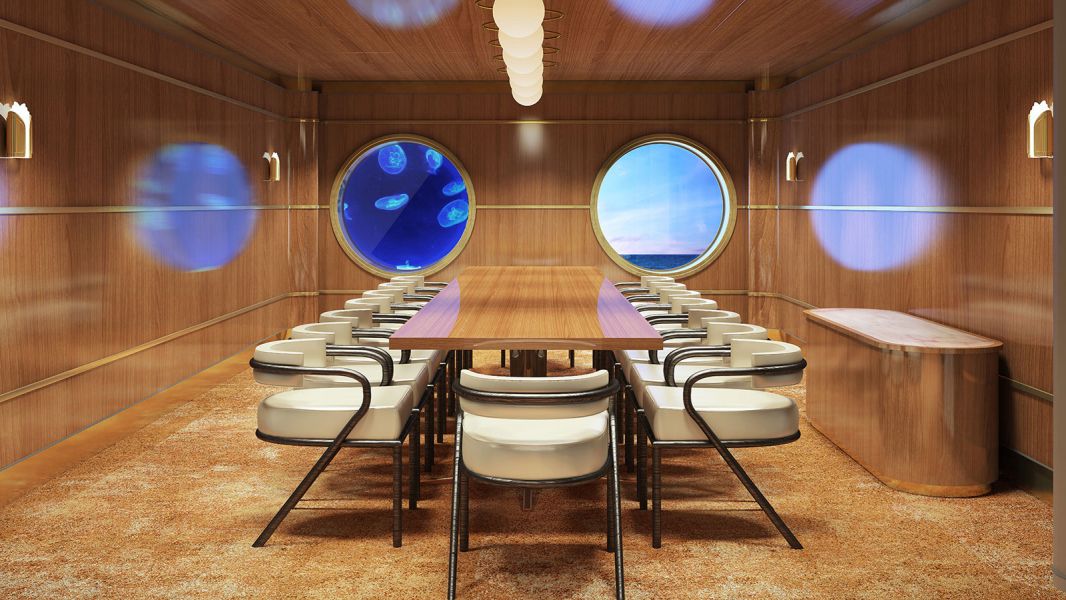
The perfect mix of sophistication, nostalgia and cool - entering The Wake is an event in itself. As soon as they see the grand staircase, Sailors will feel like they’ve stumbled onto a glitz & glam movie set that is regal by design with raised levels of luxury and exuberance.
FEATURES
The images shown are for illustration purposes only and may not be an exact representation of what you find on the ship.
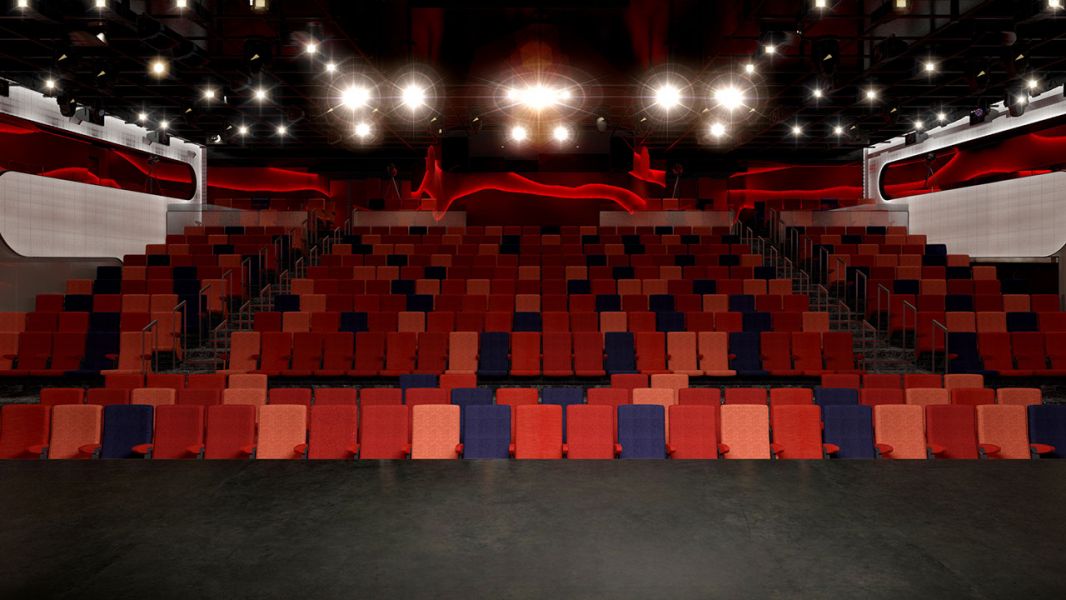
Live Performance Space
There’s a lot that’s special about The Red Room. It’s the first transformational theater at sea, featuring different modes which enable a variety of unique and engaging experiences.
Proscenium Mode: The most common theatre layout where Sailors won’t be more than 50 feet from the stage.
Alley Stage: Sailors face each other with the action separating them.
Flat Floor: With Sailors in the middle of the action with the show happening all around and direct access to a bar.
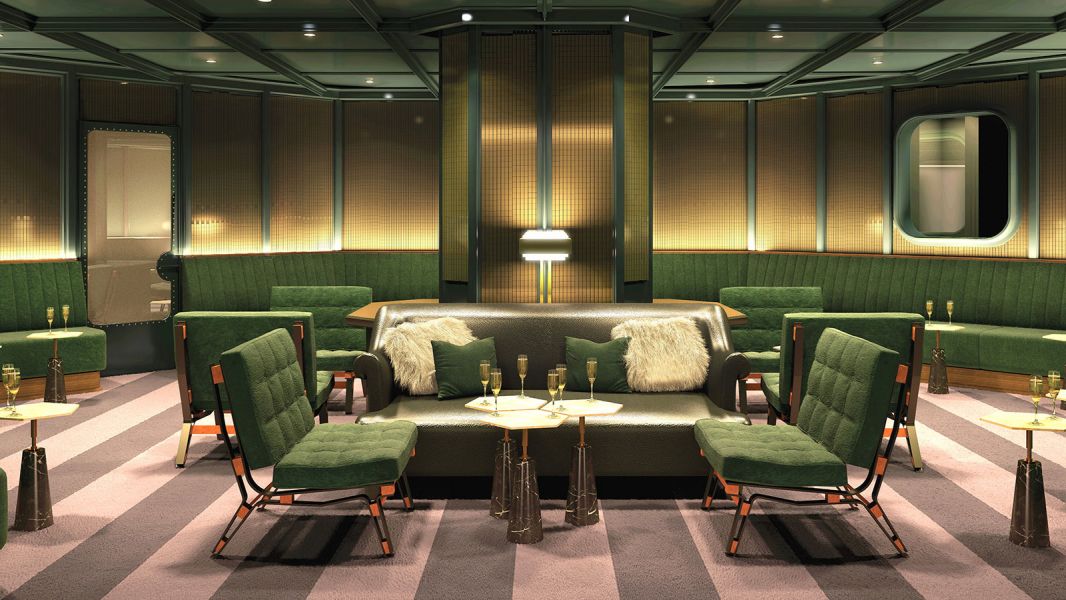
Alluring Nightclub
This kick ass, two story, two bar space, named after Richard's first recording studio, is inspired by the coolest clubs on land layered with a moody and sexy 70’s punk vibe. The Manor will host a ground-breaking, immersive dining entertainment experience (coming soon), to kick the night off before it transitions into a mind-blowing, goodbye-early-morning-workout nightclub.
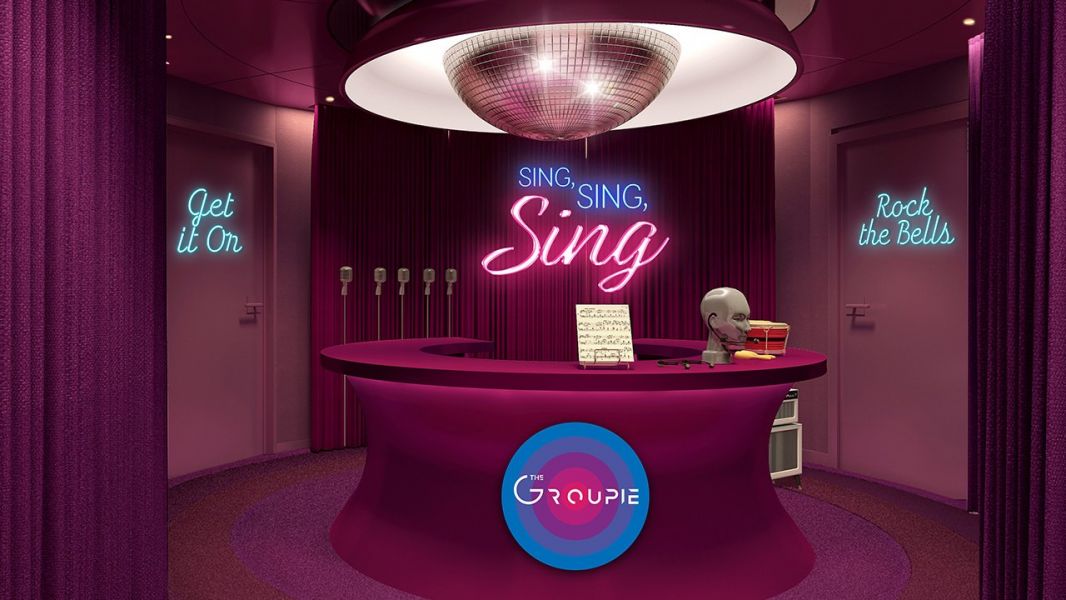
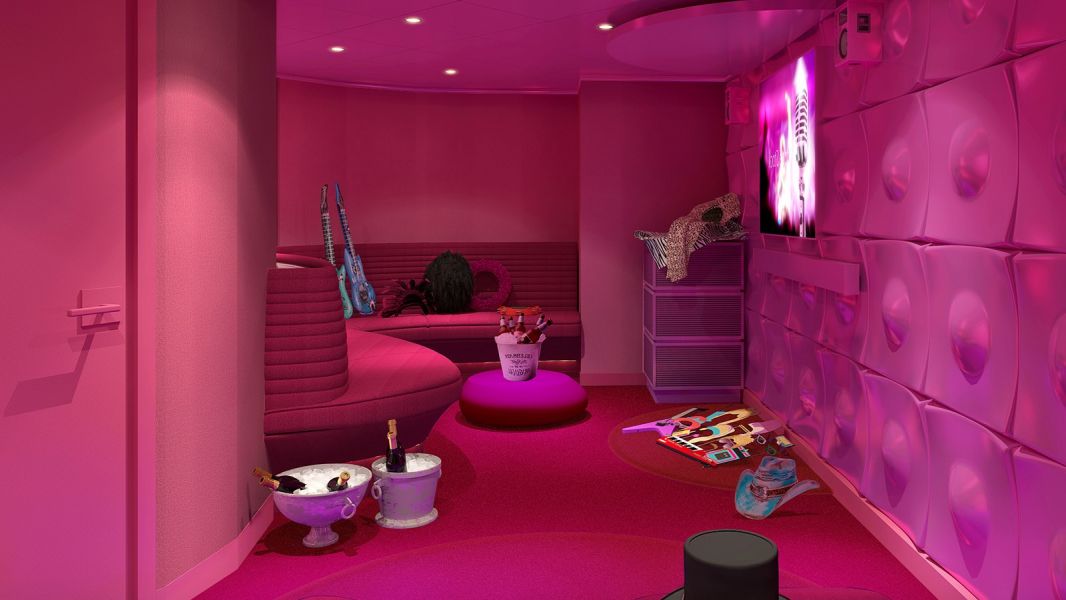
Private Karaoke
No late night outing is complete without some serious karaoke. Virgin Voyages have put their own spin on traditional cruise karaoke by designing Korean style Karaoke Rooms. Bold, vibrant spaces that encourage intense, high energy fun for our Sailors. With song choices that span decades and genres, these bookable private sessions require having their go-to tracks chosen, singing voice warm and invited friends ready for a private dance and song battle to remember. There are 3 private rooms for friends (or strangers) to reserve and enjoy together.
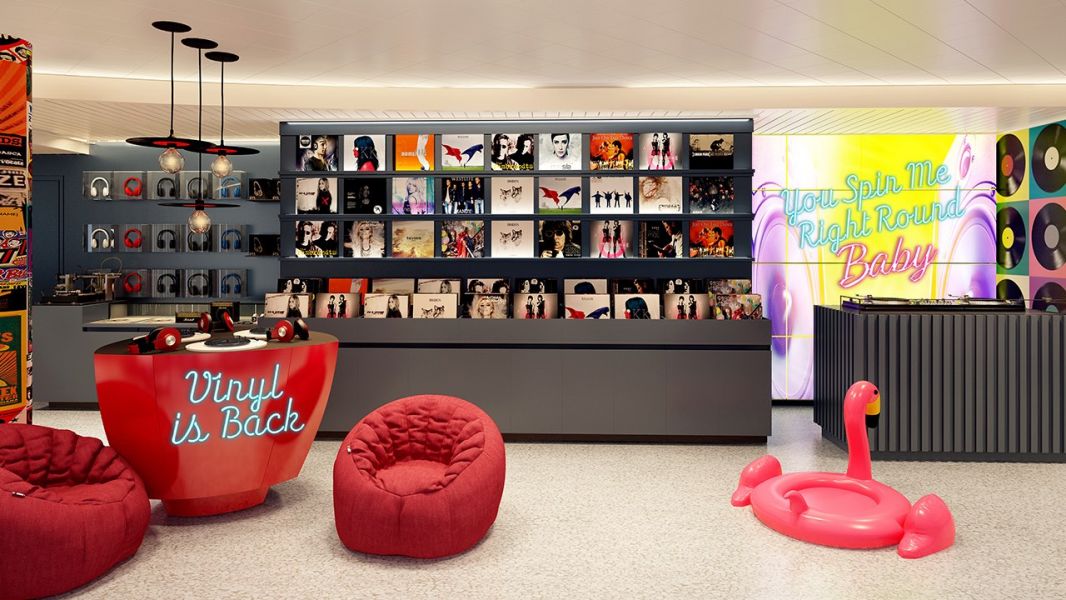
Record Shop
With Virgin Voyages' history rooted deeply in music, their sonic identity peaks at our record shop onboard. Sailors can get lost in sound at Voyage Vinyl, our record shop at sea. Stocked with music magazines, headphones and record players, Sailors can pull up to a listening station with a stack from the selection of both classic and current albums including special and limited editions.
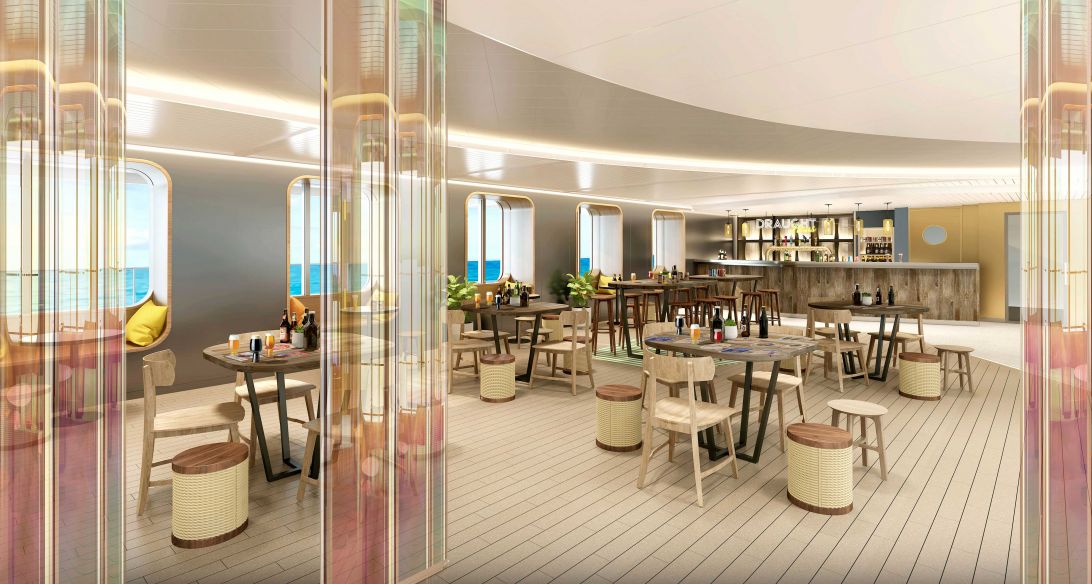
The images shown are for illustration purposes only and may not be an exact representation of what you find on the ship.
The images shown are for illustration purposes only and may not be an exact representation of what you find on the ship.
| 7 nights aboard the Resilient Lady | |||
| Exclusively Adults Only | |||
| Eat in any of the 20 eateries On-Board. It's all included | |||
| Gratuities Included in the Price | |||
| Choice of Original Music Gigs and Events | |||
| Unlimited Wi-Fi | |||
| All Fitness Classes Included | |||
| Free Tea, Coffee, Water and Sodas | |||
| Free 24 Hour Room Service | |||
| Port Taxes and Fees | |||
 | ABTA and ATOL Protection* | ||
Date 3rd Aug 2025 |
Nts 7 |
Interior  |
Oceanview  |
Balcony  |
Suite £6,090pp |
Date 3rd Aug 2025 |
Nts 7 |
Interior  |
Oceanview  |
Balcony  |
Suite £6,090pp |



| Suite staterooms from | £6,090pp | ||
| MZ | Mega RockStar (Guarantee Quarters) | £6,090pp | |
| SG | Gorgeous Suite | £6,090pp | |
| SP | Posh Suite | £7,545pp | |
| Interior | Oceanview | Balcony | Suite | |
| (All prices are £GBP per person) | ||||
| Sun 31st Aug 202531 Aug 25 |
 |
1,660 | 2,259 | 4,020 |
| Sun 14th Sep 202514 Sep 25 |
 |
1,584 | 1,584 | 4,667 |
| Sun 12th Oct 202512 Oct 25 | 1,868 | 1,584 | 1,584 | 3,947 |
Fusion Cruises when selling travel arrangements is a trading name of The Midcounties Co-operative Ltd. Fusion Cruises is an Accredited Body Member of Midcounties Co-operative Travel Consortium. (ABTA:P6652, ATOL:6053).
Book with Confidence. We are a Member of ABTA which means you have the benefit of ABTA’s assistance and Code of Conduct.
Some of the flights and flight-inclusive holidays on this website are financially protected by the ATOL scheme but ATOL protection does not apply to all holiday and travel services offered on this website. This website will provide you with information on the protection that applies in the case of each holiday and travel service offered before you make your booking. If you do not receive an ATOL Certificate then the booking will not be ATOL protected. If you do receive an ATOL Certificate but all parts of your trip are not listed on it, those parts will not be ATOL protected. Please see our booking conditions for information, or for more information about financial protection and the ATOL Certificate go to: www.caa.co.uk
